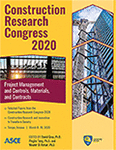Construction Research Congress 2020
Prioritization of Post-Disaster Reconstruction of Transportation Network Using an Integrated AHP and Genetic Algorithm
Publication: Construction Research Congress 2020: Project Management and Controls, Materials, and Contracts
ABSTRACT
Post-disaster reconstruction of infrastructures represents a complex and multi-objective problem. A large number of subjective and objective factors from various aspects, such as social, economic, political, and technical must be addressed for a successful recovery process of the transportation network. In addition, decision-makers need to deal with limited federal, state, and local resources in planning sequential and organized reconstruction—which is the ultimate goal of the post-disaster recovery process. In recent years, several studies have developed disaster recovery planning and execution models to improve post-disaster recovery processes of transportation infrastructure. These studies mainly focused on a specific part of the recovery process and rarely considered a comprehensive set of objectives in their investigations. This paper presents a new post-disaster recovery prioritization approach that evaluates the optimal recovery priorities of damaged transportation infrastructure and affected regions through a resource allocation analysis. Analytical hierarchy process (AHP) method integrated with non-dominated sorting genetic algorithm (NSGA-II) approach has been deployed to explicitly incorporate the multi-faceted factors for optimizing the various goals of the post-disaster recovery of the transportation network. This new methodology allows decision-makers to incorporate their own or other experts’ preferences while maintaining the goals of the process in the optimal zone. The model indicates a promising result that can be used as a comprehensive decision-making process to create an efficient workable plan for recovery of damaged transportation facilities and assign their resources according to the socioeconomic factors of affected communities.
Get full access to this article
View all available purchase options and get full access to this chapter.
REFERENCES
Burton, C. G. (2010). Social vulnerability and hurricane impact modeling. Natural Hazards Review, 11(2), 58-68.
Cagnan, Z, Davidson, R (2004) Post-earthquake restoration modeling of electric power system. In: 13th World conference on earthquake engineering, Vancouver, B.C., Canada, 1–6 August 2004 Paper No. 109
Cagnan, Z, Davidson, RA (2007) Discrete event simulation of the post-earthquake restoration process for electric power systems. Int J Risk Assess Manag 7:(8)1138–1156
Chang, S. E. (2016). Socioeconomic impacts of infrastructure disruptions. Oxford Research Encyclopedia of Natural Hazard Science.
Chang, S. E., & Nojima, N. (2001). Measuring post-disaster transportation system performance: the 1995 Kobe earthquake in comparative perspective. Transportation research part A: policy and practice, 35(6), 475-494.
Chang, L, Elnashai, AS, Spencer, BF (2010) Transportations systems modeling and applications. In: Earthquake engineering, Report No. 10-03. Mid-America earthquake center, USA
Cutter, S. L., Boruff, B. J., and Shirley, L. W. (2003). “Social vulnerability to environmental hazards.” Soc. Sci. Q., 84(2), 242–261.
Deb, K., Pratap, A., Agarwal, S., & Meyarivan, T. A. M. T. (2002). A fast and elitist multiobjective genetic algorithm: NSGA-II. IEEE transactions on evolutionary computation, 6(2), 182-197.
El-Anwar, O., Ye, J., & Orabi, W. (2015). Efficient optimization of post-disaster reconstruction of transportation networks. Journal of Computing in Civil Engineering, 30(3), 04015047.
El-Anwar, O., Ye, J., and Orabi, W. (2013). Efficient Analysis and Optimization of Reconstruction Plans for Damaged Transportation Networks Following Disasters. In Computing in Civil Engineering, 354-362.
ENR Editors. (2017). How badly has Hurricane Harvey damaged Texas infrastructure? Engineering News-Record. Retrieved from https://www.enr.com/articles/42639-how-badlyhas-hurricane-harvey-damaged-texas-infrastructure.
FEMA. (2015). Hazus online download quick reference guide. Washington, D.C.: Federal Emergency Management Agency (FEMA).
Freckleton, D., Heaslip, K., Louisell, W., & Collura, J. (2012). Evaluation of resiliency of transportation networks after disasters. Transportation research record, 2284(1), 109-116.
HAZUS-MH [Computer software]. Federal Emergency Management Agency, Washington, DC.
Housner, G. W., & Thiel, C. C. Jr (1995). The continuing challenge: report on the performance of state bridges in the Northridge earthquake. Earthquake Spectra, 11(4), 607-636.
Ghannad, P., Lee, Y. C., Friedland, C., & Yang, E. (2019). Optimizing the Socioeconomic Benefit of Post-Disaster Strategies by Prioritizing Reconstruction of Damaged Facilities. In Computing in Civil Engineering 2019: Smart Cities, Sustainability, and Resilience (pp. 180-187). Reston, VA: American Society of Civil Engineers.
Jenelius, E., & Mattsson, L. G. (2012). Road network vulnerability analysis of area-covering disruptions: A grid-based approach with case study. Transportation research part A: policy and practice, 46(5), 746-760.
Khademi, N., Balaei, B., Shahri, M., Mirzaei, M., Sarrafi, B., Zahabiun, M., & Mohaymany, A. S. (2015). Transportation network vulnerability analysis for the case of a catastrophic earthquake. International journal of disaster risk reduction, 12, 234-254.
Oh, E. H., Deshmukh, A., & Hastak, M. (2012). Criticality assessment of lifeline infrastructure for enhancing disaster response. Natural Hazards Review, 14(2), 98-107.
Orabi, Wallied, et al. "Planning post-disaster reconstruction efforts of damaged transportation networks." Construction Research Congress 2009: Building a Sustainable Future. 2009.
Polsky, C., Neff, R., & Yarnal, B. (2007). Building comparable global change vulnerability assessments: The vulnerability scoping diagram. Global Environmental Change, 17(3-4), 472-485.
Saaty, T. L. (2005). Analytic hierarchy process. Encyclopedia of Biostatistics, 1.
Schneider, P. J., & Schauer, B. A. (2006). HAZUS—its development and its future. Natural Hazards Review, 7(2), 40-44.
Technical Lifelines Council for Earthquake Engineering (TCLEE). (2006). “Hurricane Katrina: Performance of transportation systems” R. Des Roches, ed., ASCE Technical Council on Lifeline Earthquake Engineering Monograph No. 29, American Society of Civil Engineers, June.
Zamichow, N., & Ellis, V. (1994). Santa Monica freeway to reopen on Tuesday recovery: The contractor will get a $14.5-million bonus for finishing earthquake repairs 74 days early. Los Angeles Times, 1.
Information & Authors
Information
Published In
Construction Research Congress 2020: Project Management and Controls, Materials, and Contracts
Pages: 464 - 474
Editors: David Grau, Ph.D., Arizona State University, Pingbo Tang, Ph.D., Arizona State University, and Mounir El Asmar, Ph.D., Arizona State University
ISBN (Online): 978-0-7844-8288-9
Copyright
© 2020 American Society of Civil Engineers.
History
Published online: Nov 9, 2020
Published in print: Nov 9, 2020
Authors
Metrics & Citations
Metrics
Citations
Download citation
If you have the appropriate software installed, you can download article citation data to the citation manager of your choice. Simply select your manager software from the list below and click Download.
